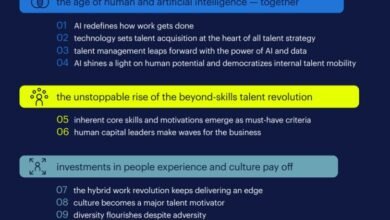
By | Dave Ulrich | Speaker, Author, Professor, Thought Partner on HR, Leadership, and Organization
by Melanie Steinbach, Recent Chief People Officer, Cameo, mel@cameo.com and Dave Ulrich, Rensis Likert Professor, Ross School of Business, University of Michigan, Partner, The RBL Group, dou@umich.edu
Many have documented and most have experienced the widespread erosion of trust. People have less trust in: political institutions and leaders who squabble more than solve problems; business organizations and leaders who practice self-interest more than other-service; education systems that promise but don’t always deliver job readiness; media that pander to a targeted audience rather than report. This list goes on and on and can include religions, courts, medical providers, and science.
This erosion of trust has been exacerbated during the pandemic with our increased uncertainty and inability to envision the future as different from the present. This escalated breakdown of trust has led to many next-generation (and other) employees becoming “truth seekers,” whose cynicism in institutions has led them to question “what is true.” The vicious cycle of eroding trust and undiscovered truth may also be contributing to mental health/well-being concerns, increased resignation, and overall lower employee experience.
When employees lose trust and can’t discover truth, they may become cynical social activists at work as much as in their personal lives. They may be at work but not working; they may share social media taunts about the company or about specific leaders; they may protest company policies and practices in ways that disrupt the business; or they may quit without notice.
The trust/truth cycle puts many leaders in a particularly precarious spot. A leader’s job is to create a positive shared mission and mindset as well as tend to the ever-increasing demands of individuals who have more ways than ever to express discontent, both internally and externally. Navigating the paradox of collective organization goals and personal individual agendas occurs when leaders help truth seekers discover truth that leads to trust.
We suggest eight specific actions to break the trust/truth erosion cycle.
1. Be vulnerable. Vulnerability includes not having all the answers, acknowledging weaknesses, and admitting mistakes, yet still engendering confidence. Vulnerability includes sharing feelings as well as thoughts. Vulnerable leaders might say, “I don’t know: can we find out together?”
2. Be authentic. Authenticity implies awareness of a personal leadership style based on values, strengths, and passions, and allowing others to have their unique style. Authentic leaders are less likely to be distracted by extraneous events over which they have little or no control. Their truth may not be others’ truth, but others may appreciate the truth they offer. Authentic leaders might say, “Here is what I propose given my values and goals. What would you suggest?’
3. Be predictable. Predictability represents the “—ables” that engender trust: dependable, reliable, believable, responsible, and accessible. By consistently acting from one’s personal style, followers can appreciate with certainty how a leader will respond. This predictability helps followers know how to react, which builds trust. Predictable leaders speak by their example more than their words.
4. Be flexible. While leaders need to have authenticity and predictability, they also need to be willing to adapt or change course when presented with new information. Trust erodes when new or different information is ignored; it is strengthened when new information is incorporated into a revised plan. Flexible leaders may ask, “What information do you have that may help us make a better decision?”
5. Be transparent. Transparency comes from candor and recognizing that while employees may have unique values and styles, they need to come together to accomplish goals. Participative management does not require consensus but rather understanding. When employees feel understood both intellectually and emotionally, they are more willing to coalesce around a leader’s agenda. Transparent leaders ask, “How well do I understand your point of view?”
6. Take care of oneself. Self-care means being a role model for physical, emotional, intellectual, social, and spiritual well-being. When employees see leaders doing what they ask others to do, employees feel more trust. Leadership hypocrisy is when leaders ask others to think, act, and feel but don’t lead by example. Caring leaders help their employees find what matters most to them by asking questions like: “We haven’t talked in a while. How are you? You haven’t seemed like yourself lately—what’s going on? You’ve had a lot going on lately. How can I support you?”
7. Serve others. Leaders build trust and demonstrate truth by using their power to empower others—their strengths to strengthen others. When an employee shares their “truth” with you, resist the urge to explain why that narrative seems false to you. Rather, observe, listen and seek to understand what you may do to help them, being calm, curious, and compassionate. When meeting with someone, stop and explore (privately, if not publicly) questions like: “What is happening in your life that is causing stress? I’m worried about you. I’d really like to know if you’re ok.”
8. Be available. Social isolation does not often foster leadership. In professional settings, isolated leaders are perceived as disconnected at best, and disinterested in their teams at worst. Availability may be in person, but it may also be through technology connections. Find a listening post to sense early signals of employee concerns. This might mean sending personal notes to employees or doing regular “check-in” calls or connections where the discussion is not about work but personal lives. More important, when employees have unforeseen challenges, available leaders make time for employees, offering support and help emotionally, socially, and sometimes financially. Available leaders let employees know, “I am on call for you 24/7; don’t hesitate to let me know how to help.”
What would you add that helps a leader build trust by allowing employees to discover “truth”?
In today’s economy with low unemployment, employee primacy exists where employees exercise their voice through thoughts and actions. When leaders help others discover truth through their words and deeds, employees may experience trust that is frequently lacking.
Republished with permission and originally published at Dave Ulrich’s LinkedIn






